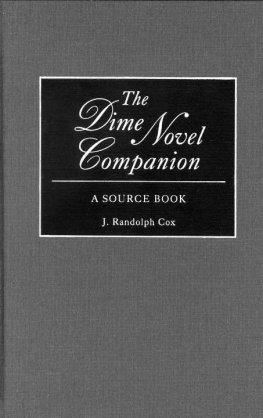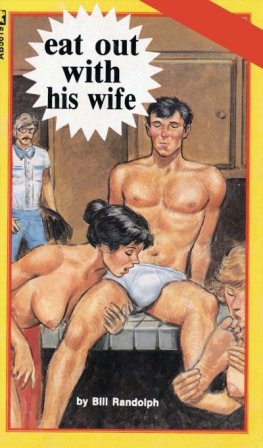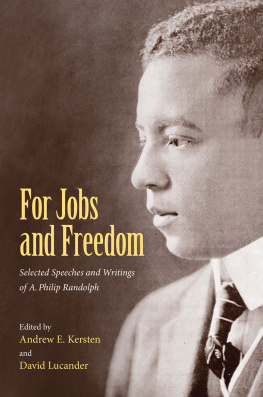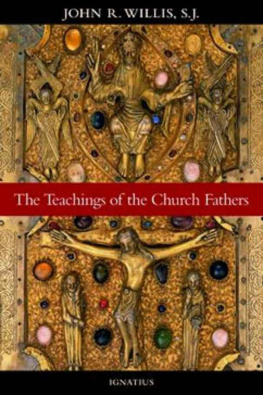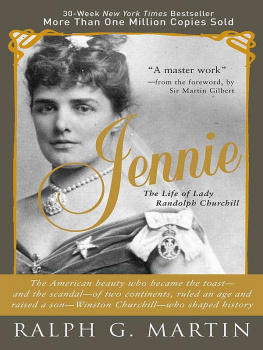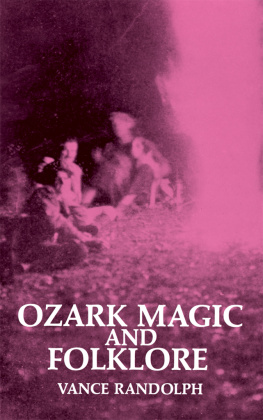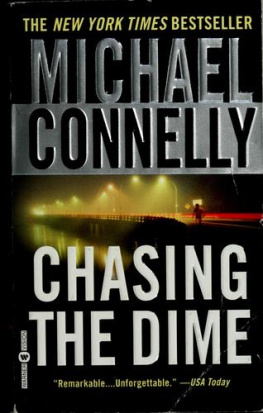J. Randolph Cox - The Dime Novel Companion: A Source Book
Here you can read online J. Randolph Cox - The Dime Novel Companion: A Source Book full text of the book (entire story) in english for free. Download pdf and epub, get meaning, cover and reviews about this ebook. year: 2008, genre: Art. Description of the work, (preface) as well as reviews are available. Best literature library LitArk.com created for fans of good reading and offers a wide selection of genres:
Romance novel
Science fiction
Adventure
Detective
Science
History
Home and family
Prose
Art
Politics
Computer
Non-fiction
Religion
Business
Children
Humor
Choose a favorite category and find really read worthwhile books. Enjoy immersion in the world of imagination, feel the emotions of the characters or learn something new for yourself, make an fascinating discovery.
- Book:The Dime Novel Companion: A Source Book
- Author:
- Genre:
- Year:2008
- Rating:3 / 5
- Favourites:Add to favourites
- Your mark:
- 60
- 1
- 2
- 3
- 4
- 5
The Dime Novel Companion: A Source Book: summary, description and annotation
We offer to read an annotation, description, summary or preface (depends on what the author of the book "The Dime Novel Companion: A Source Book" wrote himself). If you haven't found the necessary information about the book — write in the comments, we will try to find it.
The Dime Novel Companion: A Source Book — read online for free the complete book (whole text) full work
Below is the text of the book, divided by pages. System saving the place of the last page read, allows you to conveniently read the book "The Dime Novel Companion: A Source Book" online for free, without having to search again every time where you left off. Put a bookmark, and you can go to the page where you finished reading at any time.
Font size:
Interval:
Bookmark:


J. Randolph Cox

For
Edward T. LeBlanc
without whose pioneering efforts, this hook would not he possible
ix
xi
xiii
xxvii
I
xxv
The Dime Novel Companion is intended to serve the general reader as well as the specialist. It contains more than 1,200 entries arranged alphabetically by topic: publications by title, publishers, authors, series characters, and genres of fiction. Alphabetization is by first word in the entry (excluding the initial article) or by last name of persons. The exception to this is the name of characters bestknown by nicknames. Thus, "Frank Merriwell" appears under "Merriwell," but "Deadwood Dick" appears under "Deadwood." Publishing companies named for a person are alphabetized by the last name of that person, but the entry heading is arranged with the first name followed by the last name. Thus the Frank A. Munsey Co. is found under "Munsey," but appears in the heading as "Frank Munsey." As much pertinent information as is known is included, but none of the entries is intended to he an exhaustive discussion of its subject. Each is to serve only as a guide for the reader or researcher. Cross-references to entries which provide additional information are indicated by an asterisk in front of the term to he consulted.
Abbreviations have been kept to a minimum. Those that are used, principally in the series character and fiction genre entries, refer to publications in which specific dime novel titles appear. These are based on the abbreviations used by Albert Johansen in The House of Beadle and Adams and expanded by Edward T. LeBlanc for his series of bibliographic listings of dime novels and story papers. Thus, "Nick Carter, Detective," 1-NCL, Aug. 8, 1891, indicates the title of the novel, the issue number and title of the publication (no. 1, Nick Carter Library), and the date of publication. A list of abbreviations used follows this section.
Wherever possible, inclusive dates of publication are given, or (in the case of a writer) birth and death dates. If no month or day of the month is given, this means these dates are not known.
The Index includes personal names, pseudonyms (followed by the real name of the writer, if known), genres of fiction as subjects, and the page numbers on which the terns will be found. Terms in boldface type indicate that an entry for that term will be found in the alphabetical listings.
A book of this nature, built up over a period of years, owes much to many people and there is always the danger of overlooking someone in the attempt to he as complete and fair as possible. My greatest debt is to the contributors (past and present) to Dime Novel Round-Up for their knowledge of the field. Living in a town like Northfield, Minnesota, I was able to draw on the resources of two college libraries, Carleton and St. Olaf, for my research. I particularly wish to thank my colleagues at Rolvaag Memorial Library, St. Olaf College, where I served as reference librarian for over 34 years, for their support and encouragement. St. Olaf has one of the best Inter-Library Loan systems anywhere. I was the beneficiary of a generous sabbatical program which allowed tile to visit collectors and institutions as well as a Summer Humanities Faculty Development Grant. In addition, there are those colleagues on the faculty at St. Olaf College itself who listened to my stories about dime novel writers and their characters for years. They provided me with a forum for trying out ideas and discussing topics related to dime novels and other "forgotten fiction."
There were four individuals who read the manuscript and advised me on matters of style, consistency, and content: Edward T. LeBlanc, Deidre A. Johnson, Brian KenKught, and Sam Sherman. Any lapses found in this hook are not their fault.
A debt of gratitude goes out to those individuals who did or said the right thing at the right time. Janice McNabb designed a form for recording intorntation from publications in Special Collections and helped format the individual entries. Two members of the faculty at St. Olaf College assisted in other ways. Jonathan Hill suggested another stage in the development of the bandit story which I had overlooked. Sylvia G. Carullo helped me to understand why I was writing so many entries in the passive voice.
Others who provided valuable assistance, advice, and inspiration include Walter Albert, Richard Dean Anderson, Victor Berch, Richard Bleiler, Marlena Bremseth, Joel Cadbury, Paul Camp, Carolyn A. Davis, John T. Dizer, Mary Eggermont-Molenaar, Clark Evans, James L. Evans, Angela Farkas, Elizabeth S. Frank, Melinda Herder, Karen Nelson Hoyle, Samuel T. Huang, James D. Keeline, Everard P. Digges La Touche, Larry Latham, Edward S. Lauterhach, Karen G. Lauterhach, Stewart E. Lauterbach, the late J. Edward Leithead, Jean Carwile Masteller, Francis M. Nevins, Duane Olson, Patricia Ptleiger, the late Robert Sampson, E. Michael Sanchez-Saavedra, Lydia C. Schulman, Alison Scott, John Springhall, Edward Stanford, Dawn Thomsen, and Peter C. Walther. Some of these individuals might he surprised to discover the nature and extent of their assistance. Such is the way of the creative-research process. The photographs of dime novels and story papers were taken by Northfield Photo.
The staff at the following Libraries provided invaluable service in my use of their special collections: New York Public Library, Library of Congress, Brandeis University, Syracuse University, the University of Minnesota, Northern Illinois University, and the University of South Florida.
And finally, to my editors at Greenwood Press, who helped mre shape the final product: Marilyn Brownstein, Alicia Merritt, and miry current editor, Pamela St. Clair, my gratitude for staying with me for so many years. My gratitude also goes to my production editor, Jane Lerner, for suggesting ways around some formatting challenges.
An Introduction and History
In 1876 Tom Sawyer dreamed of running away to sea to return in glory as "Tom Sawyer the Pirate-The Black Avenger of the Spanish Main!" In 1914 Penrod Schofeld hid in an old sawdust box in the stable to write the episodic adventures of "Harold Ramorez, the Roadagent; or, Wild Life Among the Rocky Mts." In 1928 humorist George Ade collected some of his columns from 1897 and 1898 in a book called Bang! Bang! The subtitle was "A Collection of Stories Intended to Recall Memories of the Nickel Library Days When Boys Were Supermen and Murder a Fine Art." It was illustrated by Indiana cartoonist John T. McCutcheon in fine emulations of the covers of those nickel libraries. Mark Twain, Booth Tarkington, George Ade, and John T. McCutcheon could be certain of one thing: their readers would recognize the source behind the humor to he a form of popular literature known as the dime novel.
Font size:
Interval:
Bookmark:
Similar books «The Dime Novel Companion: A Source Book»
Look at similar books to The Dime Novel Companion: A Source Book. We have selected literature similar in name and meaning in the hope of providing readers with more options to find new, interesting, not yet read works.
Discussion, reviews of the book The Dime Novel Companion: A Source Book and just readers' own opinions. Leave your comments, write what you think about the work, its meaning or the main characters. Specify what exactly you liked and what you didn't like, and why you think so.

